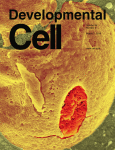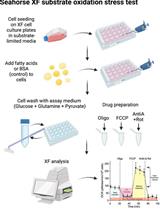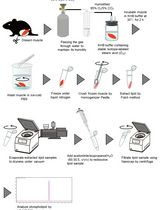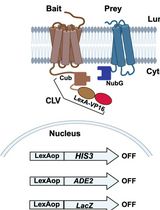- EN - English
- CN - 中文
Preparation of Lipid-Stripped Serum for the Study of Lipid Metabolism in Cell Culture
用于细胞培养中脂质代谢研究的去脂质血清的制备
发布: 2018年06月05日第8卷第11期 DOI: 10.21769/BioProtoc.2876 浏览次数: 14503
评审: Ralph Thomas BoettcherIstvan StadlerTim Andrew Davies Smith
Abstract
Studying lipid metabolism in cultured cells is complicated by the fact that cells are typically cultured in the presence of animal serum, which contains a wide, variable, and undefined variety of lipid species. Lipid metabolism can impact cell physiology, signaling, and proliferation, and the ability to culture cells in the absence of exogenous lipids can reveal the importance of lipid biosynthesis pathways and facilitate the generation of media with defined lipid species. We have adapted a protocol to remove lipids from serum without eliminating its ability to support the proliferation of cells in culture. This method requires di-isopropyl ether and butanol and can be used to generate small batches of lipid-stripped serum in four days. The resulting serum supports proliferation of many cell lines in culture and can be used to compare the metabolism of cells in lipid replete and depleted conditions.
Keywords: Delipidation (脱脂)Background
Lipids are the major constituents of cell membranes that delineate biological compartments, and also play an important role in signaling pathways and energy storage (Baenke et al., 2013). Lipid metabolism is dysregulated in a variety of diseases, and recent studies have suggested that disrupting lipid biosynthesis may be an approach to inhibit tumor growth (Svensson and Shaw, 2016). Consequently, there is interest in studying the metabolic pathways that produce cellular lipid species. Culturing cells in media deprived of specific metabolic components can help provide a better understanding of how metabolic pathways support cell function. Standard culture media for most mammalian cells includes animal serum as a source of protein and growth factors (most commonly fetal bovine serum [FBS]). Animal serum contains a variety of lipid species within lipoprotein complexes and bound to serum albumin. The composition of animal serum is not identical across lots, and the nutrients levels in serum are not well defined in most experiments. Cells are able to obtain lipids from both de novo synthesis and from exogenous sources (Kamphorst et al., 2013; Hosios et al., 2016; Balaban et al., 2017), so the presence of serum lipids can complicate studies of de novo lipid metabolism. For example, although inhibitors of fatty acid synthase can inhibit proliferation, this effect is strengthened in lipid-depleted serum (Svensson et al., 2016). Microenvironments within the body likely vary in their lipid composition (Tourtellotte, 1959; Nanjee et al., 2000), suggesting that there are physiological cases where cells may be deprived of lipids.
In addition to serving as a source of lipids, serum also provides growth factors and other components that support the cell proliferation, and most cells cannot be studied for long periods of time in the absence of serum. Serum-free media formulations and lipoprotein-depleted sera are commercially available, but these are often expensive, are not optimized to support the growth of all cell lines, and lack a corresponding lipid-replete serum to serve as a control. To overcome these challenges, we have employed a bi-phasic extraction to remove lipids from FBS without denaturing serum proteins (Cham and Knowles, 1976). This method has been previously described on LipidomicNet, and we modified this approach to generate lipid-depleted serum and a corresponding lipid-replete serum from the same original FBS lot (Hosios et al., 2016). In our hands, some cells can be cultured in this serum for several passages without a substantial change in their proliferation rate, while other cells are more sensitive to the absence of lipids. We have also demonstrated increased de novo lipid synthesis in cells cultured with this lipid-depleted serum, indicating the expected metabolic response to this condition. This protocol provides an efficient way to remove lipids from a range of volumes of FBS, and generates both lipid-depleted serum and dialyzed, lipid-replete control serum for use in cell culture experiments.
Materials and Reagents
- 50 ml conical tubes (e.g., Corning, catalog number: 430829 )
- 0.2 µm low-protein binding filters (e.g., Thermo Fisher Scientific, catalog number: 566-0020 )
- Slide-A-Lyzer dialysis cassettes (ThermoFisher), molecular weight cut-off ≤ 10 kDa
- Plastic wrap (e.g., Saran wrap)
- Glass serological pipettes
- Fetal bovine serum (FBS)
- Di-isopropyl ether (Sigma-Aldrich, catalog number: 296856 )
- N-Butanol (Sigma-Aldrich, catalog number: 34867 )
- Sodium chloride (Sigma-Aldrich, catalog number: 793566 )
- Protein concentration assay (e.g., Bio-Rad Protein Assay, Bio-Rad Laboratories, catalog number: 5000006 )
- Cholesterol assay (e.g., Sigma-Aldrich, catalog number: MAK043 )
- Triglycerides assay (e.g., Thermo Fisher Scientific, catalog number: TR22421 )
- Tissue culture media (e.g., DMEM and RPMI)
- Saline solution at 4 °C (9 g/L sodium chloride, 154 mM) (see Recipes)
Equipment
- Pipettes
- Glass beakers
- Glass graduated cylinders
- Separating funnel (if preparing large volumes of serum)
- Magnetic stir-plate
- Chemical fume hood
- Biological safety cabinet (level 2)
- Tabletop centrifuge (capable of spinning 50 ml conical tubes at 4,000 x g)
- Nitrogen gas source (industrial grade)
- Spectrophotometer capable of measuring absorbance at the wavelength appropriate to the protein assay (e.g., 595 nm for Bio-Rad Protein Assay)
Procedure
文章信息
版权信息
© 2018 The Authors; exclusive licensee Bio-protocol LLC.
如何引用
Hosios, A. M., Li, Z., Lien, E. C. and Vander Heiden, M. G. (2018). Preparation of Lipid-Stripped Serum for the Study of Lipid Metabolism in Cell Culture. Bio-protocol 8(11): e2876. DOI: 10.21769/BioProtoc.2876.
分类
生物化学 > 脂质 > 去脂
细胞生物学 > 细胞新陈代谢 > 脂质
您对这篇实验方法有问题吗?
在此处发布您的问题,我们将邀请本文作者来回答。同时,我们会将您的问题发布到Bio-protocol Exchange,以便寻求社区成员的帮助。
提问指南
+ 问题描述
写下详细的问题描述,包括所有有助于他人回答您问题的信息(例如实验过程、条件和相关图像等)。
Share
Bluesky
X
Copy link












